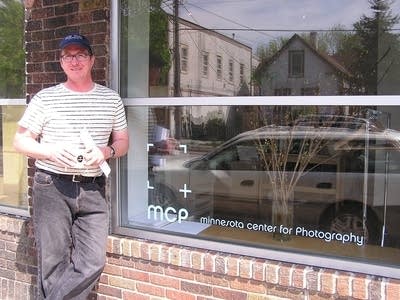Strassheim views the familiar through a distant lens
Go Deeper.
Create an account or log in to save stories.
Like this?
Thanks for liking this story! We have added it to a list of your favorite stories.

Angela Strassheim captures the most intimate and uncomfortable moments of family life with an unflinching eye, whether it's a father spanking his adolescent daughter or a family saying grace over sausage and eggs.

In another instance a young girl stands in an inflatable pool in a backyard overshadowed by grain silos. It's a scene staged to look like the famous Italian Renaissance painting "The Birth of Venus." New York Times critic Michael Kimmelman described Strassheim's pictures as "surreal, candy colored and strangely loving."
Susan Burke of Orono attended Saturday's private opening for Strassheim's latest show, and says she finds the photographs both strange and seductive.
"I love being a voyeur in someone's home and relating back to your own home, but there is this surreal bizarreness which, whether it's the clarity of the picture, the crispness of it or what it is that makes them slightly bizarre," says Burke. "It makes your eyes stay with them more than it would just a regular photograph."
Turn Up Your Support
MPR News helps you turn down the noise and build shared understanding. Turn up your support for this public resource and keep trusted journalism accessible to all.

Strassheim moved to Minnesota with her family when she was 16. She now divides her time between Minneapolis and New York. Her childhood is a key to understanding her photography. She was raised by strict religious parents who convinced her she was going to hell when she died. She says as a result, she never took big risks as a kid.
"Like I was always a designated driver because I was too afraid to end up in a car accident and be killed, and I knew that I would get myself home safe rather than letting other people have my life in their hands," says Strassheim. "You end up observing so much more than you end up living."
By volunteering to be the designated driver, Strassheim might have put herself on the sideline, but she also put herself in control, just as she now does with her camera. Her photos of family life are not inspired just by her own childhood memories, but by seeing her siblings repeating the same strict behavior with their children. Many of her photographs feature her family members.

George Slade, artistic director of the Minnesota Center for Photography, says Strassheim has responded to her religious upbringing by creating her own sort of religion.
"Angela believes in the church of the image. An image is something that you make up; it's a ghost, it's a kind of a story," says Slade. "And just like any good Bible story, it may have heroes and villains, but it's all constructed and you have to choose how much you want to believe. I think that Angela's photographs carry that same sense of mystery: How much can you believe, how much does the photograph itself prove itself to be a fiction?"
Slade says Strassheim's artistic palette is a little creepy. Her photos convey a sense that something's not quite right. After studying at the Minneapolis College of Art and Design and at Yale, Strassheim worked as a forensic photographer, documenting corpses and crime scenes. As a result, Slade says, there is a certain coldness to her gaze. Strassheim agrees the experience taught her a lot.

"I learned to pay attention to detail through that job, like how you have to consider the entire frame, how something that's way off in the back corner--it's still part of the image. If this goes to court you can't have a person back there, you can't have a bloody knife in the background. So I think it was just learning to pay attention to the entire frame and the composition that you're looking at."
Most of Strassheim's images are staged. But there are some she just found, like a large, dirty fish tank that dominates an otherwise bland living room. In the background is a beautiful painting of the ocean, underscoring just what a cheap imitation the fish tank is.
"To me it kind of sums up the feeling of a lot of the work that I do," says Strassheim. "We all kind of live in a fishbowl and it's also like a house--what happens inside the house stays inside the house."
That is, until now.
Angela Strassheim's photographs of what happens inside the house can be seen at Chambers Hotel's Burnet Gallery through August 4.







